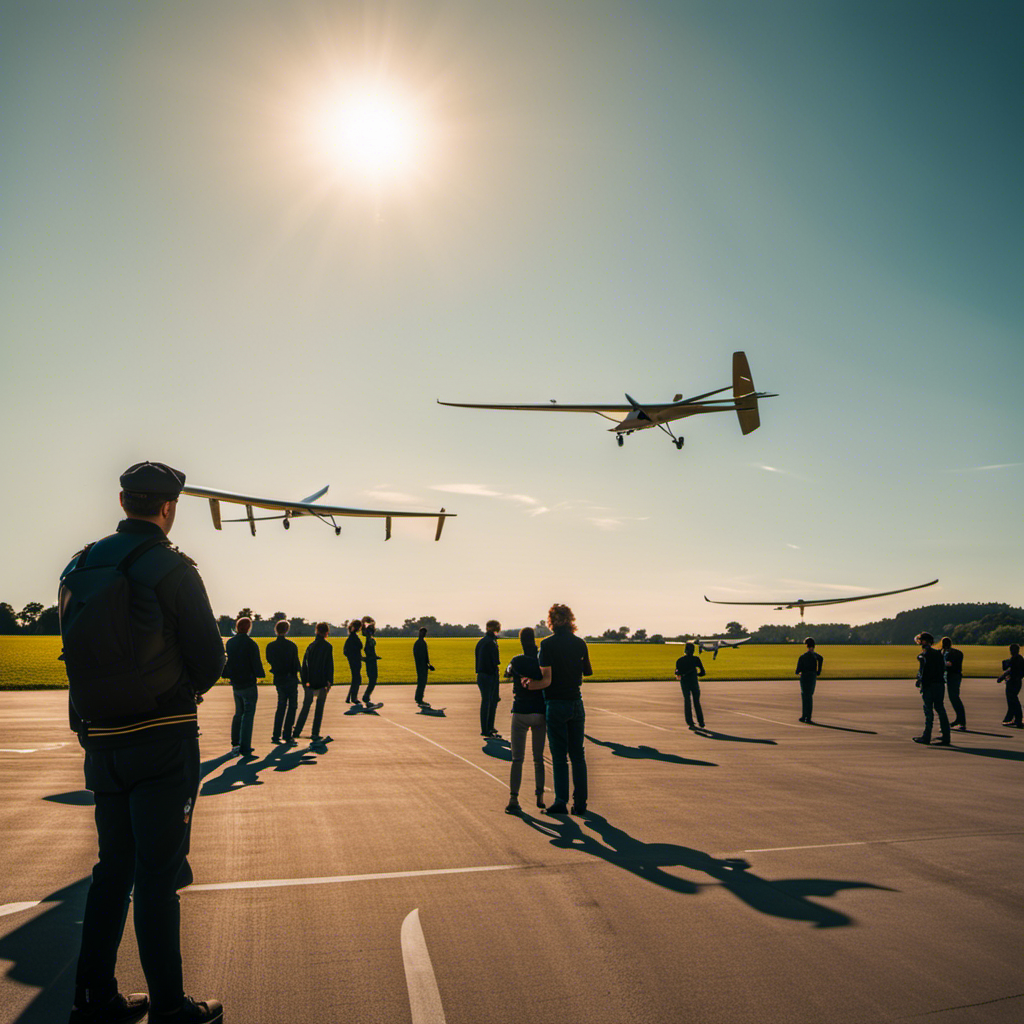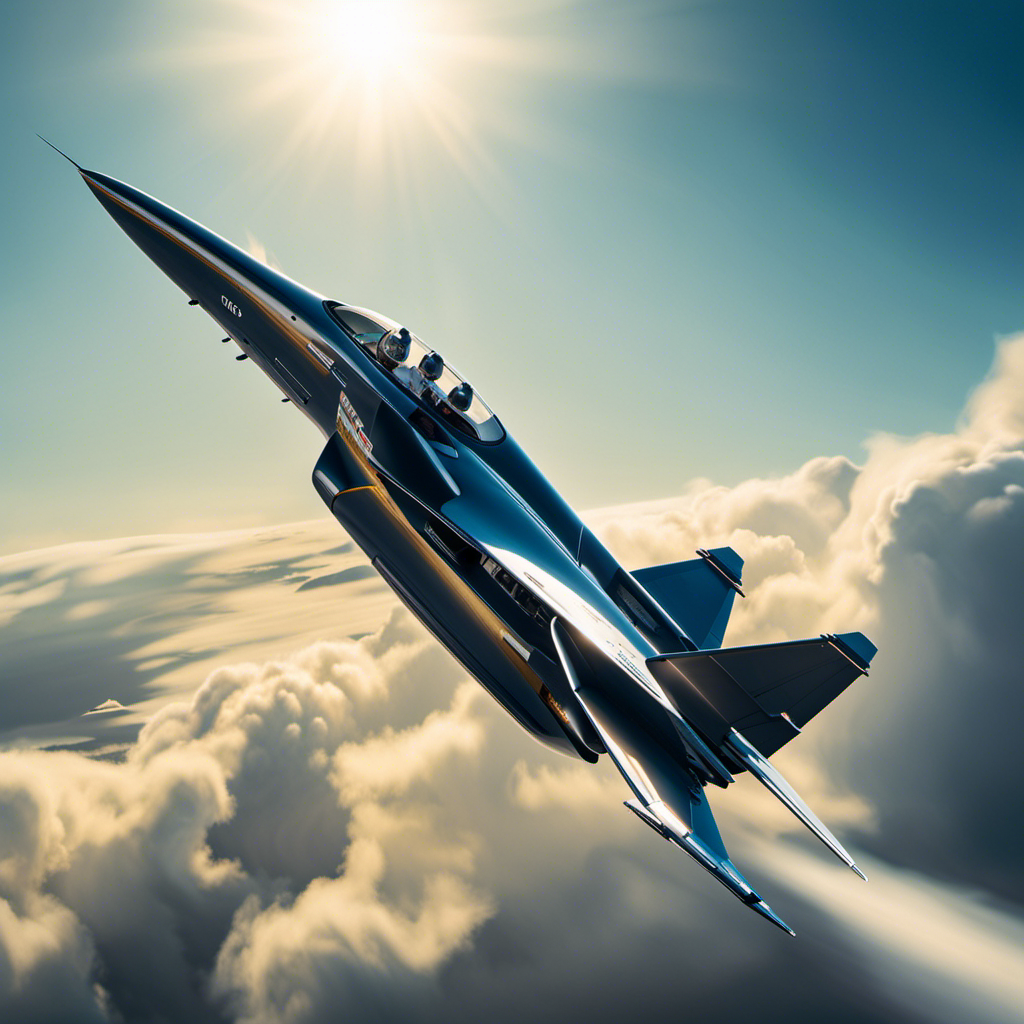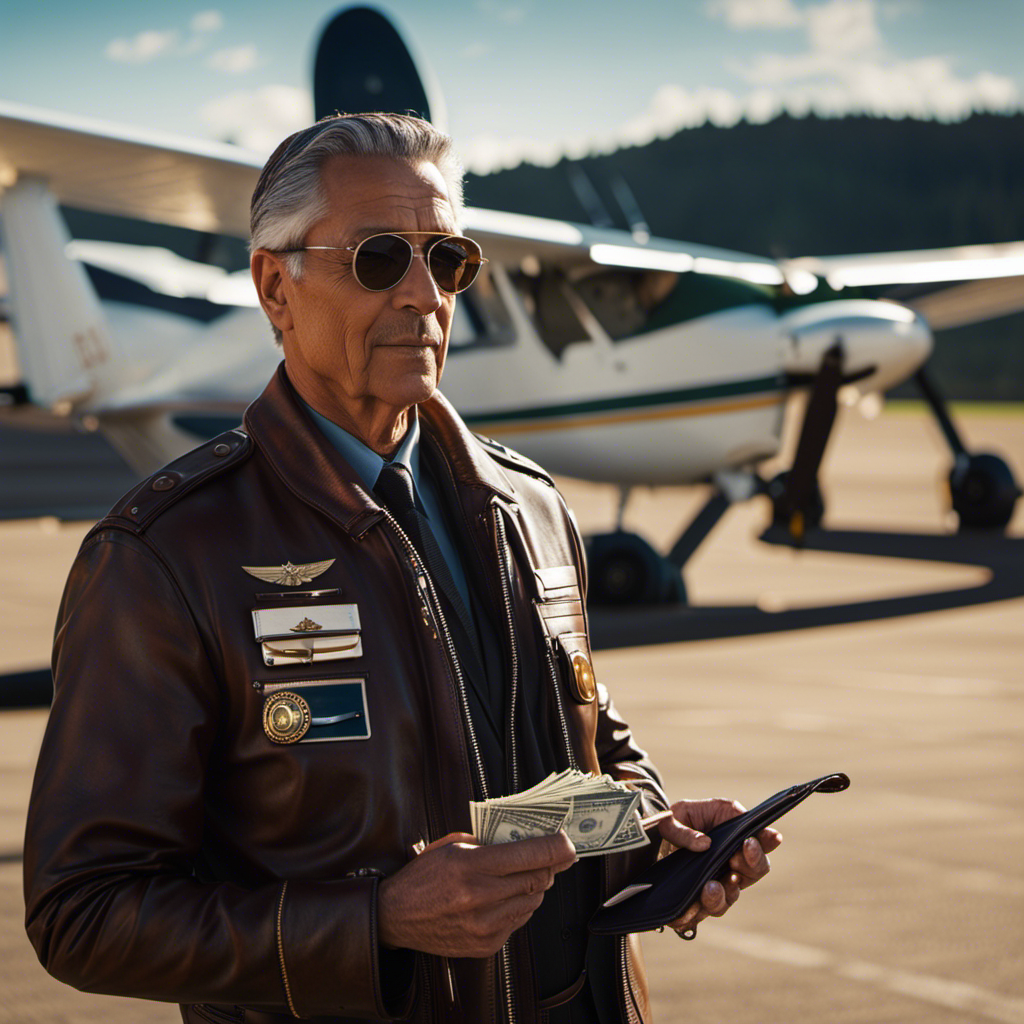Are you driven by a strong desire to fly through the skies and perfect the art of gliding? Prepare yourself and get ready for an exhilarating adventure!
In this article, we’ll guide you through the basics of glider flying, help you find a reputable school, and delve into the fascinating world of glider types and equipment.
From understanding the principles of flight to preparing for your first flight, we’ve got you covered.
So, let’s soar high and embark on your glider flying adventure!
Key Takeaways
- The first solo flight marks the beginning of the glider flying journey.
- Joining a glider flying club provides necessary guidance and access to a community of like-minded enthusiasts.
- Glider flying competitions and events showcase skills, provide a platform for growth, and enhance flying skills.
- Continuing the glider flying journey involves joining a glider club, enrolling in advanced training courses, and setting personal goals for skill development.
The Basics of Glider Flying
Before we dive into the details, let’s talk about the basics of glider flying.
Glider flying, also known as soaring, is the exhilarating experience of flying without an engine. Instead of relying on a motor, gliders use air currents and thermals to stay aloft.
The key to flying a glider is understanding how to control its flight path. You’ll learn how to use the control surfaces, such as the elevator, ailerons, and rudder, to maneuver the glider smoothly through the air.
Additionally, you’ll study meteorology to understand the weather conditions that affect gliding.
By mastering these fundamental skills, you’ll be well-prepared to take your first steps into the world of glider flying.
Now, let’s explore how to find a glider flying school and start your journey.
Finding a Glider Flying School
To find a glider flying school, the first thing you should do is research different schools in your area. Look for schools that have experienced instructors, well-maintained equipment, and a good safety record. You can start by searching online or asking for recommendations from other pilots.
Once you have a list of potential schools, you should visit them in person if possible. This will give you a chance to meet the instructors, see the facilities, and ask any questions you may have. Remember to inquire about the cost of lessons, the duration of the training program, and any prerequisites you need to meet.
Understanding the different types of gliders and the equipment used in glider flying is essential for your training.
Understanding Glider Types and Equipment
Once you’ve researched different glider flying schools, it’s important to familiarize yourself with the various types of gliders and the equipment used in order to make an informed decision.
Gliders come in different shapes and sizes, each designed for specific purposes. Some common types include the Standard Class, which is best for cross-country flights, and the Open Class, which offers high performance and flexibility. Additionally, there are gliders specifically designed for aerobatic maneuvers or competition flying.
When it comes to equipment, you’ll need to understand key components such as the airframe, wings, control surfaces, and cockpit instruments. It’s essential to choose a glider that suits your flying goals and preferences, as well as ensuring that the equipment is well-maintained and up to safety standards.
Understanding glider types and equipment will set the foundation for learning the principles of flight and advancing your skills as a glider pilot.
Learning the Principles of Flight
When it comes to learning the principles of flight in a glider, two key points to understand are aerodynamics and lift, as well as how to control the glider.
Aerodynamics refers to the study of how air flows around the glider and affects its movement through the air. Understanding lift is crucial, as it is the force that allows the glider to stay in the air.
Once you grasp these concepts, you can move on to learning how to control the glider using various methods such as weight shifting, using the control surfaces, and adjusting the center of gravity.
Aerodynamics and lift
Understanding aerodynamics and lift is crucial when learning to fly gliders. As a beginner pilot, you need to grasp the fundamental principles that govern the behavior of your glider in the air.
Aerodynamics is the study of how air flows around objects, and lift is the force that counteracts gravity and keeps your glider airborne. The shape of the wings, known as the airfoil, is designed to create lift by generating a pressure difference between the upper and lower surfaces.
This pressure difference causes the glider to rise and stay aloft. By understanding these principles, you can make informed decisions during your flight, optimizing your glider’s performance.
Now, let’s explore how you can control the glider to maneuver through the air gracefully.
Controlling the glider
Controlling the glider involves adjusting the control surfaces, such as the ailerons and elevator, to change the aircraft’s attitude and direction of flight. The ailerons are located on the wings and control the roll of the aircraft, allowing you to bank left or right. By moving the control stick or wheel left or right, you can adjust the position of the ailerons and initiate a turn.
The elevator, located on the tail of the glider, controls the pitch or nose-up/nose-down attitude. To climb, you pull back on the control stick, causing the elevator to rise and the glider to pitch up. Pushing forward on the control stick lowers the elevator, causing the glider to pitch down. Mastering these control surfaces is essential to flying a glider successfully.
To prepare for your first flight, you will need to familiarize yourself with the cockpit and its instruments. This includes understanding the various gauges, indicators, and controls. You should also review the pre-flight checklist, which ensures that the glider is in proper working order and ready for flight.
Additionally, it is important to familiarize yourself with the specific procedures and protocols at your chosen glider flying location. This may include radio communication protocols, airspace restrictions, and emergency procedures. By taking the time to prepare thoroughly, you will set yourself up for a safe and enjoyable first flight.
Preparing for Your First Flight
First, you’ll need to gather all the necessary equipment before your first flight. Here’s a checklist of what you’ll need:
| Equipment | Description |
|---|---|
| Helmet | Protects your head during flight |
| Parachute | Provides a safety backup in case of emergency |
| Radio | Allows communication with the ground and other pilots |
| Flight suit | Keeps you comfortable and protected from the elements |
| Sunglasses | Shields your eyes from the sun’s glare |
| Flight manual | Contains important information about your glider |
Once you have all the necessary equipment, you can focus on taking your first solo flight. This is an exciting milestone in your journey to become a glider pilot. During your first solo flight, you’ll have the opportunity to put into practice everything you’ve learned so far. It’s a moment of independence and a chance to gain confidence in your abilities. So, let’s get ready for this thrilling experience and take to the skies on your own!
Taking Your First Solo Flight
Once you’re fully prepared and equipped, it’s time to conquer the skies and experience the thrill of your first solo flight.
Picture yourself in the cockpit, feeling a mix of nervous excitement and determination. As you release the tow line, you’re suddenly free, soaring gracefully through the air.
The wind rushes past you, lifting your glider higher and higher. You can feel the warmth of the sun on your face and hear the sound of the wind whistling in your ears.
You navigate through the sky, using the skills you’ve learned, feeling a sense of accomplishment with each turn and maneuver.
Your first solo flight is a moment you’ll never forget, marking the beginning of your journey as a glider pilot.
As you gain confidence, you’ll be ready to explore advanced glider flying techniques, taking your skills to new heights.
Advanced Glider Flying Techniques
Now that you have mastered the basics of glider flying, it’s time to take your skills to the next level.
In this discussion, we will explore the exciting world of advanced glider flying techniques. These include cross-country flying, aerobatics, and advanced maneuvers.
Cross-country flying will allow you to venture beyond the boundaries of the airfield and experience the thrill of soaring over long distances.
Aerobatics will push the limits of your flying abilities, as you perform exhilarating maneuvers such as loops, rolls, and spins.
Lastly, advanced maneuvers will challenge your precision and finesse. You will learn techniques like thermaling, ridge soaring, and dynamic soaring.
So get ready to elevate your glider flying skills and unlock a whole new level of excitement in the sky.
Cross-country flying
To enhance your gliding skills, it’s essential to explore cross-country flying. This type of flying allows you to venture beyond the local aerodrome and discover new areas while honing your piloting abilities.
Cross-country flying involves planning and executing a flight that takes you from one point to another, using thermals, ridge lift, and other sources of lift to stay aloft. It requires careful navigation, as you need to select the most efficient route and make strategic decisions along the way.
Aerobatics and advanced maneuvers
If you’re ready to take your skills to the next level, it’s time to delve into the exciting world of aerobatics and advanced maneuvers.
Aerobatics is a thrilling aspect of glider flying that allows you to perform a variety of exhilarating maneuvers in the air. From loops and rolls to spins and stall turns, these maneuvers will challenge your piloting skills and test your ability to maintain control in different flight situations.
Learning aerobatics requires specialized training and guidance from experienced instructors who can teach you the techniques and safety procedures involved.
By mastering these advanced maneuvers, you will enhance your flying abilities and gain a deeper understanding of the capabilities of your glider.
Now, let’s move on to the next step: joining a glider flying club, where you can further develop your skills and fly with like-minded enthusiasts.
Joining a Glider Flying Club
First, you’ll want to find a glider flying club near you that offers training programs. Joining a glider flying club is a great way to start your journey into the world of glider flying.
These clubs are typically equipped with experienced instructors who can provide you with the necessary training and guidance. They offer structured programs that cover everything from basic flight maneuvers to advanced techniques.
In addition to the training, being part of a glider flying club also gives you access to a community of fellow enthusiasts who share your passion for flying. This community can offer support, advice, and opportunities for further learning.
Glider Flying Competitions and Events
By participating in glider flying competitions and events, you’ll have the opportunity to showcase your skills and make connections with other pilots in the community. These competitions and events are not only thrilling but also provide a platform for you to measure your abilities against fellow glider enthusiasts.
Whether it’s a local competition or a national event, these gatherings bring together pilots from all walks of life, creating a sense of camaraderie and a chance to learn from one another. You’ll have the opportunity to witness impressive maneuvers, gain valuable insights from experienced pilots, and even receive feedback on your own performance.
These competitions and events will enhance your flying skills, build your confidence, and open doors to new opportunities in the glider flying world. So, as you move forward in your glider flying journey, consider taking part in these exciting events to further your passion and expand your horizons.
Continuing Your Glider Flying Journey
After experiencing the thrill of glider flying competitions and events, you may be eager to continue your journey and delve deeper into the world of soaring. Luckily, there are numerous avenues available for you to explore and enhance your skills as a glider pilot.
Here are some options to consider:
-
Join a glider club: Becoming a member of a glider club will provide you with access to a community of experienced pilots who can offer guidance and support.
-
Take advanced training courses: Enroll in advanced training courses to further develop your skills and knowledge in areas such as cross-country flying, aerobatics, or even instructing.
-
Participate in badge flying: Set personal goals by aiming to achieve various badges, such as distance, altitude, or duration records. This will not only challenge you but also give you a sense of accomplishment.
Embark on this next phase of your glider flying journey and watch as your skills and passion for soaring take flight.
Conclusion
So there you have it, my friend! You’re now equipped with the knowledge and skills to take to the skies in a glider.
From learning the basics and finding a flying school to understanding the types of gliders and equipment, you’re on your way to becoming a glider pilot extraordinaire.
Prepare for the thrill of your first flight and embrace the advanced techniques that will make you soar like never before.
Join a glider flying club and immerse yourself in the exhilarating world of competitions and events.
Your glider flying journey has only just begun, and the sky’s the limit!
Orion, better known as “Jetstream,” is the voice that brings the stories of the skies to life. His fascination with aviation began at a young age, sparked by his father’s tales of flying and adventure. Orion’s journey into the world of gliding was serendipitous, and from the moment he took his first glider flight, he knew he had found his calling.










